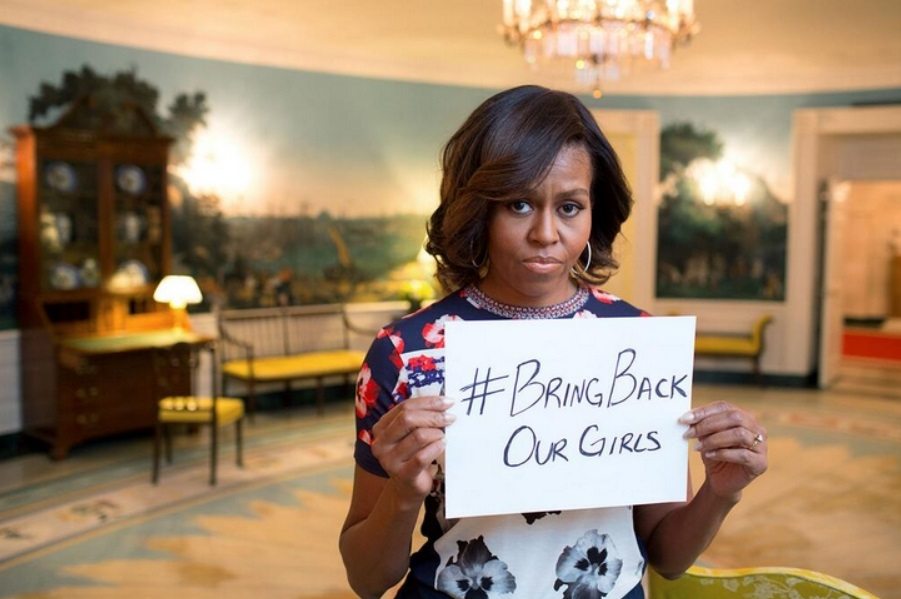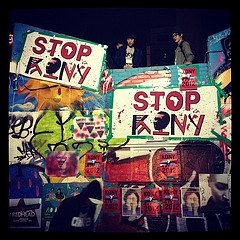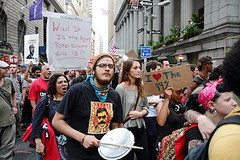The Influence of Social Media on Global Politics
Last month, Nigerian extremist group Boko Haram kidnapped over 250 girls from Nigerian schools and revealed their plans of “selling them” through marriage or slavery. Since then, there has been a global outcry and movement for the return of these girls to their families in the form of a social media campaign, #BringBackOurGirls. Everyone from celebrities to First Lady Michelle Obama has shown their support with pictures and the hashtag. But how much the influence of social media can have on the global politics and travesties? Is it a form of publicity or a vehicle for movement? Let’s explore.
These recent kidnappings bring to light a number of serious political and social problems, not only in the African nations, but in the global economy. Sex slavery, human trafficking, military and religious zealotry, and female education are considered dangerous subjects in places like the Middle East and Africa because of political extremism as well as racially and religiously motivated warfare in the region. Above all, groups like Boko Haram are against the presence of the Western world, even the group’s name “Boko Haram” which according to TIME translates into “Western education is a sin.” Their reasoning for targeting schools is their description of female education to be in direct conflict with Islamic teaching.
Although these girls were abducted almost a month ago, political response was supportive but slow. However, it appears that since the hashtag #BringBackOurGirls went viral, US and British officials are sending support in the recovery efforts. Other nations like China, France and Spain have also sent support and special forces to help aid in locating these girls but more importantly to find “solutions to prevent such attacks in the future and defeat Boko Haram” as published earlier today in the Miami Herald. Could social media be the explanation for the spike in the political interest? How else has social media played in role in world politics and during times of crisis?

Some experts and activists are worried that #BringBackOurGirls could be another #KONY2012, a well-intended social media campaign to bring to light the  actions of Joseph Kony, leader of the Lord’s Resistance Army in Uganda and the surrounding nations. As the antagonist of the 2012 film “Stop Kony,” the film showcased thehorrific lengths the LRA takes to recruit youths into the army, some as young as 7 years old. Despite the virality of the video and campaign, including endorsements from President Obama and several celebrities, the campaign ultimately fizzled out. Read Adam Ferrier’s article about the multi-leveled failure that was the Stop Kony campaign. Some dispute this lack of follow-through stems from filmmaker Jason Russell’s mental instability. Some argue that the film and the social media campaign known as “Cover the Night” didn’t do enough to fully explain the issues of the area as well as several factual discrepancies. In addition, many supporters wondered how sharing a video and supporting charities was supposed to capture this African Hitler. All in all, the evangelist nature of the sponsoring organization “Invisible Children” and the lack of connection between Kony and the public is what caused the failure.
actions of Joseph Kony, leader of the Lord’s Resistance Army in Uganda and the surrounding nations. As the antagonist of the 2012 film “Stop Kony,” the film showcased thehorrific lengths the LRA takes to recruit youths into the army, some as young as 7 years old. Despite the virality of the video and campaign, including endorsements from President Obama and several celebrities, the campaign ultimately fizzled out. Read Adam Ferrier’s article about the multi-leveled failure that was the Stop Kony campaign. Some dispute this lack of follow-through stems from filmmaker Jason Russell’s mental instability. Some argue that the film and the social media campaign known as “Cover the Night” didn’t do enough to fully explain the issues of the area as well as several factual discrepancies. In addition, many supporters wondered how sharing a video and supporting charities was supposed to capture this African Hitler. All in all, the evangelist nature of the sponsoring organization “Invisible Children” and the lack of connection between Kony and the public is what caused the failure.
 Other instances of social media failure on a global and national scale can be easily found. Occupy Wall Street in 2011 was a social movement that was part Greensboro sit-ins, part Boston Tea Party. While thousands of young people lived in the middle of NYC’s Financial District and coined the famous phrase “We are the 99%,” ultimately, the people left and the main concepts of the campaign such as greed, corruption and wealth distribution in the U.S. became yesterday’s news. Their lack of direction and demands can be contributed to the failure but their lack of figurehead on platforms like social media also became a part of discussion.
Other instances of social media failure on a global and national scale can be easily found. Occupy Wall Street in 2011 was a social movement that was part Greensboro sit-ins, part Boston Tea Party. While thousands of young people lived in the middle of NYC’s Financial District and coined the famous phrase “We are the 99%,” ultimately, the people left and the main concepts of the campaign such as greed, corruption and wealth distribution in the U.S. became yesterday’s news. Their lack of direction and demands can be contributed to the failure but their lack of figurehead on platforms like social media also became a part of discussion.
So while people may scoff when you mention to them the influence of social media on business and politics, movements like #BringOurGirlsBack show that when people unite and spread information through social media networks, they spread awareness and ignite sympathy. Do not be mistaken, it will take military and political efforts to find those missing girls—social media can only go so far. It can, however, be effective at stirring the masses out of apathy and motivate politicians to become involved.
